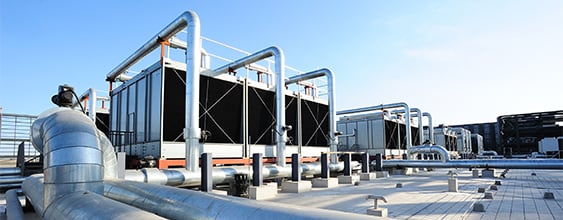The oil and gas sector produces a lot of greenhouse gases in extracting the resource or using electricity. This starts with the energy required to explore for hydrocarbons, drill into the rock, pump the resource to the surface, and then pipeline it to market. Referred to as “Scope 1 – Direct” and “Scope 2 – Indirect” emissions by GHG Protocol, the world's most widely used greenhouse gas accounting standards, these emissions are within the company-owned and controlled resources or are related to electricity purchase and have received the most attention to date.
|
Understanding greenhouse gas (GHG) emissions
- Scope 1 covers direct emissions from owned or controlled sources.
- Scope 2 covers indirect emissions from the generation of purchased electricity, steam, heating and cooling consumed by the reporting company.
- Scope 3 includes all other indirect emissions that occur in a company’s value chain.
(Source: The Carbon Trust)
|
Short-term steps towards decarbonizing the sector include switching out hydrocarbon-powered engines for electric motors wherever possible – such as in vehicles, on drill rig motors, and on pipeline compressors. Promisingly, Canada’s high use of renewable energy and plans to phase out coal fired generation will help reduce these emissions.
The industry is also working hard to squeeze out energy inefficiencies, including using less heat for extracting and processing hydrocarbons, and less flaring of natural gas. The industry is also working on preventing unplanned or “fugitive” emissions of gas.
Long Term: Using the Industry’s Skills to Put Carbon Back in The Ground
Beyond these short-term steps lay the foundation for the long game – a circular economy in which the oil and gas industry takes an active role in mitigating the carbon impacts of its continued production. This includes identifying and supporting beneficial uses for carbon dioxide, through clusters of industries that complement and benefit each other. In this way, the oil and gas industry can form part of the solution to tackle carbon dioxide emissions.
For example, the industry’s wealth of knowledge about the underground environment is useful in Carbon Capture, Utilization and Sequestration (CCUS), which involves collecting carbon dioxide that contributes to climate change, and either finding another use for it (that’s the “Utilization” part) or storing it safely underground (“Sequestration”).
Dr Amy Bloomfield-Clarke, a Senior Structural Geologist at Golder, a member of WSP, explains the challenges and opportunities for the industry: “Decarbonization is one of the greatest challenges facing humanity in the 21st century. Carbon capture and storage was first suggested in 1977 as an idea to utilise existing technology to mitigate the effects of CO2 on climate. Over the last decade CCS has rapidly moved into the mainstream as the technology itself is now proven to be technically feasible. As governments worldwide are readily adopting CCUS in their energy futures, our next challenge will be to develop consortia to help get large-scale CCUS off the ground.”
The oil and gas sector, long accustomed to drilling into porous underground formations to extract oil and gas, is already applying its extensive knowledge and skills in this area. This includes using the industry’s ability to use seismic and other data and technologies to explore for suitable carbon storage sites. Some of the sequestration is being directed into depleted oil and gas reservoirs, underground coal seams, and some into saline aquifers, i.e., geological formations containing brines (salt water) that are not suitable as drinking water, and neither can they be used for agricultural purposes.
The industry is well accustomed to building and operating pipelines and other key infrastructure and can apply this skill to building lines to collect carbon dioxide from industrial and other sources and carry it to CCUS sites. The worldwide network of pipeline rights-of-way will be useful as routes for CO₂ lines. An example of CCUS is the Alberta Carbon Trunk Line in western Canada, described as the world’s largest capacity pipeline for CO₂ from human activity, which transports up to 14.6 million tonnes of CO₂ per year, equivalent to the annual CO2 emissions from more than 3.4 million homes. This line takes captured CO₂ and delivers it to mature oil and gas reservoirs for use in enhanced oil recovery and permanent storage.
The Alberta Carbon Trunk Line is part of a growing number of projects around the globe that use oil and gas infrastructure, know-how, equipment, and other assets to support CCUS. With the industry’s knowledge, infrastructure, and commitment in place, it is possible to remove Scope 1 emissions associated with the continued production and use of hydrocarbons and sequester or store these emissions from other sectors as well.
The Middle Game: Making A Brighter Future Happen
This low-carbon future won’t happen by itself and one of the key challenges is the Scope 3 emissions associated with the use of the industry’s products. Oil and gas companies are being pressured by shareholders and financial regulators to disclose the risks they are facing, including the possibility that many of their current assets – oil and gas properties – will become “stranded”, “abandoned”, or unable to be extracted while meeting the global GHG reduction target, which could be a significant blow to their balance sheets. These financial impacts may be part of what brings about an increase in CCUS in the future. As companies aspire to extract their assets without emitting GHGs, or find new uses for their depleted assets, they can begin using these assets to sequester or store carbon dioxide.
Another key driver is that stakeholders are taking a closer look at companies’ Environmental, Social and Governance (ESG) performance. This financial pressure comes because investment funds and other financing sources are under pressure to divest from this sector. However, this could prove to be short-sighted because continued investment in the oil and gas sector is necessary to allow these companies the capital they need to work on CCUS and similar sustainability initiatives.
If access to capital is constrained for oil and gas companies operating in democratic, well-regulated countries, the supply gap will be filled by national- and state-owned enterprises from countries that do not have the same regulatory standards, oversight, and commitment to ESG principles -- or in some cases, basic human rights. In effect, divestment wouldn’t result in the reduction of global GHG emissions rather move the emission to other locations.
Driving Awareness
Consumers are being given increased options to “green” their own emissions and thereby help to address the sectors scope 3 emissions, and the oil and gas industry can help by providing education to increase awareness about ethical choices in purchasing. For example, some oil and gas companies offer customers a pay-at-the-pump option to pay for offsets to balance the climate-change impacts of the fuel they are using. These offsets might come in the form of tree planting or other GHG removals. By providing information on carbon footprint, including offsets, the sector can reinforce consumer behavior to become part of the solution.
A big part of making this happen will involve oil and gas companies using digital tools to track every step of their supply chain to demonstrate their commitment to a reduced carbon footprint. This will minimize wastage and provide confidence to customers that each hydrocarbon molecule is sourced from where it is said to be from. Tracking can be a big step towards differentiating themselves as a force for good in the eyes of investors and customers.
Sean Capstick, Principal and Project Director for Sustainable Development and Climate Change at Golder, a member of WSP, shares his view on the industry's potential for sustainable production: “Over the years, as we've worked with clients who are leaders in the oil and gas industry, we have added full suite of services needed to execute the steps necessary for the sector to achieve carbon neutrality."
As the industry's commitment expanded, so too did the capabilities of his team. Capstick adds, "we've tackled pipeline design for transport and storage of carbon, facilitated monitoring measurement and verification, and developed front-end engineering for the hydrogen market. Our clients are also seeking out and applying solutions related to renewable energy production as well as digitalization and providence tracking, impact assessment and permitting, and carbon offset planning and auditing. Whatever the challenge, it's an exciting time to be involved in this work as we can see the positive impacts on the industry -- and our environment -- now and in the future.”
ABOUT THE AUTHORS
Sean Capstick, P. Eng is a Principal with more than 25 years of environmental compliance experience who provides specialized expertise on strategic and regulatory advice to clients regarding Climate Change. He is Golder’s, a member of WSP, Global Sustainability and Climate Change Technical Community Leader and is a member of the External Advisory Panel for the Canadian Centre for Climate Services’ (CCCS) whose mandate is to distribute climate data for developing Vulnerability Assessments and Adaptation Plans.
Dr Amy Bloomfield-Clarke is a Senior Structural Geologist with over 12 years’ research and consultancy experience working in the deep subsurface. Amy has extensive experience of global geological consultancy projects relating to carbon capture and storage and gas storage in depleted gas reservoirs, saline aquifers and caverns, oil and gas reservoir prospecting and development, and geothermal projects.















